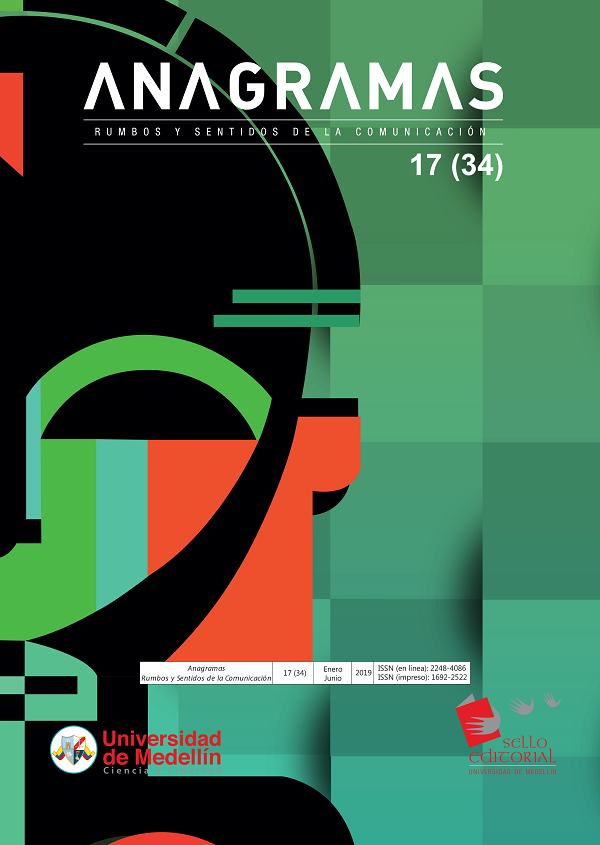Derechos de autor 2023 Anagramas Rumbos y Sentidos de la Comunicación

Esta obra está bajo licencia internacional Creative Commons Reconocimiento-NoComercial-SinObrasDerivadas 4.0.
- Articles
- Enviado: abril 16, 2018
-
Publicado: junio 14, 2019
Resumen
Más allá de su valor monetario, los automóviles privados tienen un valor social que los mantiene en uso a pesar de las restricciones económicas y ambientales que pesan sobre ellos. Esta investigación analiza las representaciones sociales que se construyeron en Medellín (Colombia) alrededor del vehículo particular y por qué este bien de lujo sigue creciendo en su uso a pesar de que la ciudad presenta alternativas públicas de movilidad. Se exploró la bibliografía existente sobre las representaciones sociales, especialmente de los bienes de lujo, además se desarrollaron entrevistas semiestructuradas a un grupo de personas entre 30 y 40 años que poseen vehículos para uso particular que al momento de su compra costaron al menos 50 millones de pesos colombianos. El análisis del discurso de los entrevistados permitió conocer el valor social que las personas dan al vehículo privado. Esta valoración que los propietarios dan a ese bien va más allá de los conceptos de libertad e independencia que reconoce la literatura relacionada, este ejercicio mostró que el primer objetivo de los poseedores es desligarse de los sistemas de transporte público o colectivo. Los poseedores no solo comprenden el valor simbólico del automóvil, sino que anticipan las reacciones que causa en los demás y lo utilizan para construir un discurso y mostrarse como desean ante otros miembros de su comunidad. Este análisis desde lo sociológico expuso que el consumo de automóviles entre este grupo de estudio se da en una escala ascendente que se relaciona directamente con el estatus aspirado por el propietario del vehículo.
Referencias
Appadurai, A. (1991). La vida social de las cosas. México: Editorial Grijalbo, S.A. de C.V.
Área Metropolitana del Valle de Aburrá. (2015) Inventario de Emisiones Atmosféricas del Valle de Aburrá, año base 2013. Universidad Pontificia Bolivariana, Grupo de Investigaciones Ambientales. Recuperado de www.Metropol.cov.co
Asociación Nacional de Movilidad Sostenible (Andemos). (2017). Informe sector automotor, octubre 2017. Asociación Colombiana de Vehículos Automotores. Recuperado de http://www.andemos.org/index.php/2017/11/02/andemos-informe-sector-automotor-octubre-2017/
BBVA Research (2017). Situación automotriz, Colombia 2017. Recuperado de https://www.bbvaresearch.com/publicaciones/colombia-presentacion-situacion-automotriz-2017/
Blumer, H. (1954). What´s wrong with the social theory. American Sociological Review, (19), 3-10.
Carrete y Arroyo (2013). ¿Cómo diseñar una estrategia de comunicación para vehículos eléctricos? Congreso internacional de Contaduría, Administración e Informática. Recuperado de: http://congreso.investiga.fca.unam.mx/docs/xviii/docs/13.01.pdf
Childe, V. (1984). La evolución social. Madrid: Alianza.
Douglas, M., Isherwood, B. y Mercado, E. (1990). El mundo de los bienes. Ciudad de México: Grijalbo.
Durán, D., Chacón, S., Ortegón, L. y Atehortúa, C. (2014). Valor percibido de vehículos de lujo: dimensionalidad e implicaciones en mercadeo (Tesis de maestría). Institución Universitaria Politécnico Grancolombiano, Bogotá, Colombia. Recuperado de http://190.131.241.186/handle/10823/749
Duque, P. (2014). Neuromarketing una herramienta validadora en la toma de decisiones en mercadeo visual-auditivo (Tesis de maestría). Universidad Nacional de Colombia, Manizales. Recuperado de http://www.bdigital.unal.edu.co/40204/
Durkheim, E. (1986). Las reglas del método sociológico. Ciudad de México: Fondo de Cultura Económica.
El Colombiano. (2016). Crisis ambiental en el aburrá. Recuperado de http://www.elcolombiano.com/opinion/editoriales/crisis-ambiental-en-el-aburra-BJ3856416
El Colombiano. (2017) Todavía hay tiempo para mejorar la movilidad. Recuperado de http://www.elcolombiano.com/antioquia/movilidad/todavia-hay-tiempo-para-mejorar-la-movilidad-BC7703762
Graves-Brown, P.M. (2000). Matter, Materiality and Modern Culture. Londres: Routledge.
Giucci, G. (2007). La vida cultural del automóvil. Bernal: Univ. Nacional de Quilmes.
Kaufmann, V. (2002). Re thinking mobility. Aldershot: Ashgate.
Hennessey, A (2014) Estrategias De Mercadeo Para Impulsar La Comercialización De Carros Eléctricos En Bogotá, Universidad Militar Nueva Granada.
McCracken, G. (1986). Culture and Consumption: A Theoretical Account of the Structure and Movement of the Cultural Meaning of Consumer Goods. The Journal of Consumer Research, 13, 71-84.
Martín Juez, F. (2002). Contribuciones para una antropología del diseño. Barcelona: Editorial Gedisa S.A.
Martínez Miguélez, M. (2006). Ciencia y arte en la metodología cualitativa. Ciudad de México: Trillas.
Mead, G. H. (1934). Mind, self and society: from the Standpoint of a Social Behaviorist. Chicago: University of Chicago Press.
Moscovici, S. y Duveen, G. (2000). Social representations: explorations in social psychology. Cambridge: Polity.
Morales Quintana, B (2014), Modelo de masificación de vehículos eléctricos en Bogotá D.C. Bogotá D.C., Colombia. Universidad Nacional de Colombia, Departamento de Ingeniería Eléctrica y Electrónica
Programa Medellín Cómo Vamos. (2016). Informe de Calidad de Vida de Medellín 2012–2015. Recuperado de https://www.medellincomovamos.org/download/informe-de-indicadores-objetivossobre-la-calidad-de-vida-en-medellin-2012-2015/
Sahlins, M. (1977) Economía de la edad de piedra. Madrid: Akal Editor.
Sheller, M. (2004). Automotive emotions: feeling the car. Theory, Culture y Society, 21, 25-39.
Urry, J. (2003). Inhabiting the Car. Department of Sociology at Lancaster University. Recuperado de http://www.lancaster.ac.uk/fass/resources/sociology-online-papers/papers/urry-inhabiting-the-car.pdf
Urry, J. (2004) “The ‘System’ of Automobility”, Revista Theory, Culture y Society, Volumen 21, p 221-242, Lóndres, Inglaterra.
Vallejo, F. y López, Z. (2016). Entrevista al ingeniero Jorge Barrera. Recuperada de https://youtu.be/1fesqdY2u3I





























